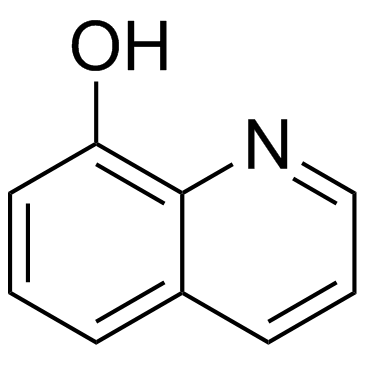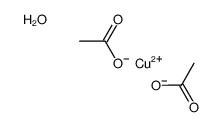10380-28-6
| 中文名 | 喹啉铜 |
|---|---|
| 英文名 | oxine-copper |
| 中文别名 | 8-羟基喹啉铜(II) |
| 英文别名 |
cupric 8-quinolinoxide
QUINONDO Copper(2+) di(8-quinolinolate) 8-Hydroxyquinoline copper complex copper 8-quinolinolate Copper 8-hydroxyquinolinate Dokirin 8-Hydroxyquinoline Copper Salt MFCD00067392 Oxine-Copper Copper quinolate Dokivin 8-Quinolinol, copper(2+) salt (2:1) Milmer 1 Culinate Copper-8 (8-hydroxy quinolinato)2Cu Fruitdo bis(quinolin-8-olato-O,N)copper(II) Cunilate Copper(II) Bis(8-hydroxyquinolinate) [Cu(8-HQ)2] Copper(2+) diquinolin-8-olate Copper-8-hydroxyquinoline bis(8-hydroxyquinolato)copper(II) Cupric 8-quinolinolate copper(II) bis(quinolin-8-olate) Bis(8-quinolinolato)copper(II) Milmer bis(8-quinolinolato-κN1,κO8)copper EINECS 233-841-9 bis(8-hydroxyquinolinato)copper(II) bioquin1 Copper-8-quinolinolate oxine-Cu |
| 密度 | 1,68 g/cm3 |
|---|---|
| 沸点 | 267ºC at 760 mmHg |
| 熔点 | 240 °C (dec.)(lit.) |
| 分子式 | C18H12CuN2O2 |
| 分子量 | 351.846 |
| 闪点 | 143.1ºC |
| 精确质量 | 351.019470 |
| PSA | 44.24000 |
| LogP | 4.15330 |
| 外观性状 | 黄色至绿色粉末 |
| 储存条件 | 密封于0-6°C的阴凉干燥处。 |
| 稳定性 | 遵照规格使用和储存则不会分解。 |
| 水溶解性 | 水溶性:不溶;水溶解度:0.07 mg/l ;极微溶:氯仿 |
| 分子结构 | 1、摩尔折射率:无可用 2、 摩尔体积(cm3/mol): 无可用 3、 等张比容(90.2K):无可用 4、 表面张力(dyne/cm):无可用 |
| 计算化学 | 1、 疏水参数计算参考值(XlogP):无可用 2、 氢键供体数量:2 3、 氢键受体数量:8 4、 可旋转化学键数量:0 5、 拓扑分子极性表面积(TPSA):147 6、 重原子数量:29 7、 表面电荷:0 8、 复杂度:226 9、 同位素原子数量:0 10、 确定原子立构中心数量:0 11、 不确定原子立构中心数量:0 12、 确定化学键立构中心数量:0 13、 不确定化学键立构中心数量:0 14、 共价键单元数量:3 |
| 更多 | 1. 性状:黄绿色结晶固体 2. 密度(g/mL,25/4℃): 1.68 3. 相对蒸汽密度(g/mL,空气=1):无可用 4. 熔点(ºC):240 5. 沸点(ºC,常压):无可用 6. 沸点(ºC,5.2kPa): 无可用 7. 折射率: 无可用 8. 闪点(ºC): 无可用 9. 比旋光度(º):无可用 10. 自燃点或引燃温度(ºC):无可用 11. 蒸气压(kPa,25ºC):无可用 12. 饱和蒸气压(kPa,60ºC):无可用 13. 燃烧热(KJ/mol):无可用 14. 临界温度(ºC):无可用 15. 临界压力(KPa):无可用 16. 油水(辛醇/水)分配系数的对数值:无可用 17. 爆炸上限(%,V/V):无可用 18. 爆炸下限(%,V/V): 无可用 19. 溶解性:不溶于水。 |
|
Section 1. Chemical Product and Company Identification 8-Hydroxyquinoline, Copper Salt Common Name/ Trade Name Manufacturer Commercial Name(s) Synonym
Chemical Name Chemical Family 8-Hydroxyquinoline, Copper Salt Section 4. First Aid Measures Eye ContactCheck for and remove any contact lenses. In case of contact, immediately flush eyes with plenty of water for at least 15 minutes. Get medical attention. Skin ContactIn case of contact, immediately flush skin with plenty of water. Cover the irritated skin with an emollient. Remove contaminated clothing and shoes. Wash clothing before reuse. Thoroughly clean shoes before reuse. Get medical attention. Serious Skin ContactWash with a disinfectant soap and cover the contaminated skin with an anti-bacterial cream. Seek medical attention. InhalationIf inhaled, remove to fresh air. If not breathing, give artificial respiration. If breathing is difficult, give oxygen. Get medical attention. Serious InhalationNot available. IngestionDo NOT induce vomiting unless directed to do so by medical personnel. Never give anything by mouth to an unconscious person. Loosen tight clothing such as a collar, tie, belt or waistband. Get medical attention if symptoms appear. Serious IngestionNot available. Section 5. Fire and Explosion Data Flammability of the Product May be combustible at high temperature. Auto-Ignition Temperature Not available. Flash PointsNot available. Flammable LimitsNot available. Products of CombustionThese products are carbon oxides (CO, CO2), nitrogen oxides (NO, NO2...). Fire Hazards in Presence of Slightly flammable to flammable in presence of heat. Various Substances Explosion Hazards in Presence Risks of explosion of the product in presence of mechanical impact: Not available. of Various SubstancesRisks of explosion of the product in presence of static discharge: Not available. Fire Fighting MediaSMALL FIRE: Use DRY chemical powder. and InstructionsLARGE FIRE: Use water spray, fog or foam. Do not use water jet. Special Remarks onNot available. Fire Hazards Special Remarks on Explosion Not available. Hazards Section 6. Accidental Release Measures Small SpillUse appropriate tools to put the spilled solid in a convenient waste disposal container. Finish cleaning by spreading water on the contaminated surface and dispose of according to local and regional authority requirements. Large SpillUse a shovel to put the material into a convenient waste disposal container. Finish cleaning by spreading water on the contaminated surface and allow to evacuate through the sanitary system. 8-Hydroxyquinoline, Copper Salt Section 7. Handling and Storage PrecautionsKeep away from heat. Keep away from sources of ignition. Ground all equipment containing material. Do not ingest. Do not breathe dust. Wear suitable protective clothing. In case of insufficient ventilation, wear suitable respiratory equipment. If ingested, seek medical advice immediately and show the container or the label. Avoid contact with skin and eyes. StorageKeep container tightly closed. Keep container in a cool, well-ventilated area. Do not store above 8°C (46.4°F). Refrigerate. Section 8. Exposure Controls/Personal Protection Engineering ControlsUse process enclosures, local exhaust ventilation, or other engineering controls to keep airborne levels below recommended exposure limits. If user operations generate dust, fume or mist, use ventilation to keep exposure to airborne contaminants below the exposure limit. Personal ProtectionSplash goggles. Lab coat. Dust respirator. Be sure to use an approved/certified respirator or equivalent. Gloves. Personal Protection in Case of Splash goggles. Full suit. Dust respirator. Boots. Gloves. A self contained breathing apparatus should be used a Large Spillto avoid inhalation of the product. Suggested protective clothing might not be sufficient; consult a specialist BEFORE handling this product. Exposure LimitsNot available. Section 9. Physical and Chemical Properties Physical state and appearance Solid. (crystalline powder)OdorNot available. Not available. Taste Molecular Weight351.85 g/mole greenish-yellow Color Not applicable. pH (1% soln/water) Boiling PointNot available. Melting Point>200°C (392°F) Critical TemperatureNot available. Specific GravityNot available. Not applicable. Vapor Pressure Vapor DensityNot available. Not available. Volatility Odor ThresholdNot available. Water/Oil Dist. Coeff.Not available. Ionicity (in Water)Not available. Dispersion PropertiesNot available. SolubilityInsoluble in cold water, hot water. Section 10. Stability and Reactivity Data StabilityThe product is stable. Instability TemperatureNot available. Conditions of InstabilityExcess heat, excess dust generation Incompatibility with variousNot available. substances CorrosivityNot available. 8-Hydroxyquinoline, Copper Salt Special Remarks onNot available. Reactivity Special Remarks onNot available. Corrosivity PolymerizationWill not occur. Section 11. Toxicological Information Routes of EntryInhalation. Ingestion. Toxicity to AnimalsAcute oral toxicity (LD50): 3940 mg/kg [Mouse]. Acute dermal toxicity (LD50): >2000 mg/kg [Rabbit]. Chronic Effects on Humans MUTAGENIC EFFECTS: Mutagenic for bacteria and/or yeast. Other Toxic Effects onHazardous in case of inhalation. HumansSlightly hazardous in case of skin contact (irritant, permeator), of ingestion. Special Remarks onLethal Dose/Conc 50% Kill: Toxicity to AnimalsLC50 [Rat] - Route: Inhalation; Dose: 820 mg/kg. *Please Note that the time period for testing was not indicated by the Registery of Toxic Effects of Chemial Substances (RTECS). Special Remarks onMay affect genetic material and may cause cancer based on animal data. No human data found. Chronic Effects on Humans Special Remarks on otherAcute Potential Health Effects: Toxic Effects on HumansSkin: May cause skin irritation. It may be absorbed through the skin. Eye: Dust may cause eye irritation. Inhalation: Dust may cause respiratory tract irritation. May be harmful if inhaled. Ingestion: May affect behavior (somnolence - general depressed activity), gastrointestinal tract (irritation, diarrhea, hypermotility), repiratory system (dyspnea), nervous system Chronic Potential Health Effects: liver (hepatitis), urinary system, spleen, metabolism (weight loss), blood. Section 12. Ecological Information EcotoxicityNot available. BOD5 and CODNot available. Possibly hazardous short term degradation products are not likely. However, long term degradation products may Products of Biodegradation arise. The products of degradation are less toxic than the product itself. Toxicity of the Products of Biodegradation Special Remarks on theNot available. Products of Biodegradation Section 13. Disposal Considerations Waste DisposalWaste must be disposed of in accordance with federal, state and local environmental control regulations. 8-Hydroxyquinoline, Copper Salt Section 14. Transport Information DOT ClassificationNot a DOT controlled material (United States). IdentificationNot applicable. Not applicable. Special Provisions for Transport DOT (Pictograms) Section 15. Other Regulatory Information and Pictograms TSCA 8(b) inventory: 8-Hydroxyquinoline, Copper Salt Federal and State Regulations CaliforniaCalifornia prop. 65: This product contains the following ingredients for which the State of California has found to cause cancer which would require a warning under the statute: No products were found. Proposition 65 Warnings California prop. 65: This product contains the following ingredients for which the State of California has found to cause birth defects which would require a warning under the statute: No products were found. Other RegulationsEINECS: This product is on the European Inventory of Existing Commercial Chemical Substances (EINECS No. 233-841-9). Canada: Listed on Canadian Non-Domestic Substance List (NDSL). China: Listed on National Inventory. Japan: Listed on National Inventory (ENCS). Korea: Listed on National Inventory (KECI). Philippines: Listed on National Inventory (PICCS). Australia: Listed on AICS. WHMIS (Canada) CLASS D-1B: Material causing immediate and serious toxic effects (TOXIC). Other Classifications DSCL (EEC) R20- Harmful by inhalation.S22- Do not breathe dust. Health Hazard HMIS (U.S.A.)2 National Fire Protection 1 Flammability 1 Association (U.S.A.) Fire Hazard 2 0 Reactivity Health Reactivity 0 Specific hazard Personal Protection E WHMIS (Canada) (Pictograms) DSCL (Europe) (Pictograms) TDG (Canada) (Pictograms) 8-Hydroxyquinoline, Copper Salt ADR (Europe) (Pictograms) Protective Equipment Gloves. Lab coat. Dust respirator. Be sure to use an approved/certified respirator or equivalent. SECTION 16 - ADDITIONAL INFORMATION N/A |
|
毒理学数据: 1 。
生态学数据: 该物质对环境可能有危害,对水体应给予特别注意。 CHEMICAL IDENTIFICATION
HEALTH HAZARD DATAACUTE TOXICITY DATA
MUTATION DATA
|
| 危害码 (欧洲) | Xi |
|---|---|
| 风险声明 (欧洲) | R36/37/38 |
| 安全声明 (欧洲) | S26-S36 |
| 危险品运输编码 | UN 3077 9/PG 3 |
| WGK德国 | 3 |
| RTECS号 | VC5250000 |
| 海关编码 | 2933499090 |
|
~82% 
10380-28-6 |
| 文献:Journal of Solid State Chemistry, , vol. 106, p. 451 - 460 |
|
~% 
10380-28-6 |
| 文献:Kinetics and Catalysis, , vol. 26, p. 50 - 57 Kinetika i Kataliz, , vol. 26, p. 61 - 68 |
|
~28% 
10380-28-6 |
| 文献:Russian Journal of Physical Chemistry, , vol. 54, # 12 p. 1784 - 1786 Zhurnal Fizicheskoi Khimii, , vol. 54, p. 3118 - 3122 |
|
~% 
10380-28-6 |
| 文献:Helvetica Chimica Acta, , vol. 8, p. 596 - 602 |
| 海关编码 | 2933499090 |
|---|---|
| 中文概述 | 2933499090. 其他含喹琳或异喹啉环系的化合物〔但未进一步稠合的〕. 增值税率:17.0%. 退税率:13.0%. 监管条件:无. 最惠国关税:6.5%. 普通关税:20.0% |
| 申报要素 | 品名, 成分含量, 用途, 乌洛托品请注明外观, 6-己内酰胺请注明外观, 签约日期 |
| Summary | 2933499090. other compounds containing in the structure a quinoline or isoquinoline ring-system (whether or not hydrogenated), not further fused. VAT:17.0%. Tax rebate rate:13.0%. . MFN tariff:6.5%. General tariff:20.0% |






